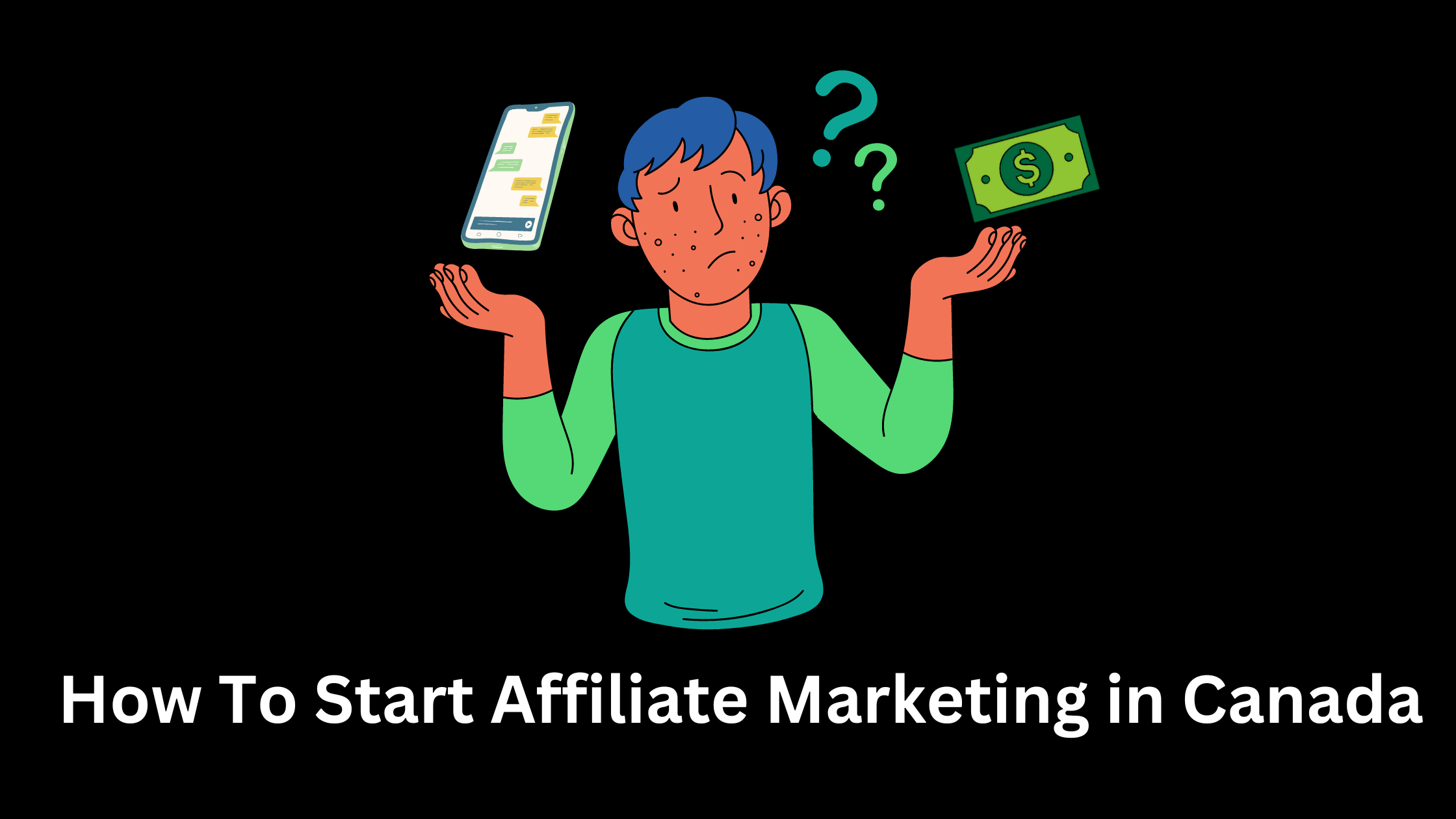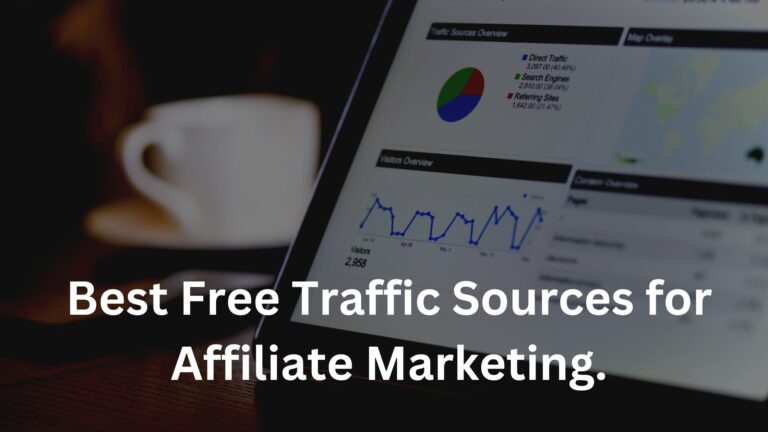Are you looking to dive into the world of affiliate marketing in Canada but don’t know how? Then you’ve come to the right place.
Affiliate marketing has emerged as a powerful online business model that offers individuals the opportunity to earn passive income by promoting products and services.
With its low startup costs and flexible work schedule, affiliate marketing has gained popularity in Canada as an attractive avenue for generating revenue.
Whether you’re a seasoned entrepreneur or someone looking to explore new income streams, affiliate marketing can open doors to your financial freedom and independence.
By leveraging the power of the internet and strategic partnerships, affiliate marketers in Canada can earn commissions for promoting products they genuinely believe in, without the need to create their own products or handle customer support.
In this comprehensive guide, I will walk you through the essential steps you need to start affiliate marketing in Canada. From understanding the basics of affiliate marketing to building a successful affiliate website and implementing effective promotional strategies, this guide will equip you with the knowledge and tools to establish yourself as a thriving affiliate marketer.
What Is Affiliate Marketing?
In simple terms, affiliate marketing is a business model where individuals (affiliates) promote products or services on behalf of companies or merchants and earn a commission for each sale generated through their promotional efforts.
How Does Affiliate Marketing Work?
I will be explaining how it works from a marketer’s standpoint. So it basically involves you finding an affiliate program, and if you’re satisfied with their terms, you join the program. After joining the affiliate program, You will get a unique link that contains a tracking ID most times. The tracking ID allows the merchant to track if you’ve referred any customer to them. So you get to create content and insert the link into the content and for everyone that clicks on your link and makes a purchase, you get a commission or should I say a percentage. Need more clarity? Here’s what I’m talking about;
- You write content on running shoes and insert your Amazon link
- Someone reads the content and clicks on the link to buy one of the shoes.
- They make the order and pay for it
- You get a commission from that person’s purchase and everyone else who clicks on the link and makes a purchase.
So basically, that is how affiliate marketing works. Before we go into the real deal, let’s take a look at how much money people make through affiliate marketing in Canada.
How Much Money Do Affiliate Marketers Make?
Before we get started on how to start affiliate marketing in Canada, it is important to know just how much money affiliate marketers make just sitting in their homes. The amount that affiliates earn varies however, here’s a breakdown of the amount of money affiliates earn;
- Beginner – $1 to $1000/per month
- Intermediate $1000 to $10,000/per month
- Advanced – 10k to $100k/per month
- Super Affiliate – $100k+/per month
Keep in mind though that people who are making money through affiliate marketing in Canada have done an excellent job building their brand. It has taken them years of hard work to get to the level they are. If you’re just starting out, you need to manage your expectations. You won’t earn the big bucks right off the bat, but don’t let this discourage you. The success of others tells you that with hard work, time, and the right knowledge, you too can potentially reach those levels. Now that you have seen the amount of money individuals make through affiliate marketing in Canada, let’s look at the steps you need to get started.
How to Start Affiliate Marketing in Canada.
As promised, I will give you 7 steps to start affiliate marketing in Canada. Without any further words, let’s dive into it…
Step 1: Find your niche
 The first thing you need to keep in mind before you start affiliate marketing in Canada is that you need a niche. Your niche is the specific category you want to talk about. Most people just dive in and follow the crowd and that is not bad in itself but to stand out from the crowd, you need to narrow your choices down to the area you have more interest. Before finding my niche, there were five certain questions I asked myself, and I would like you to ask the same questions. These are;
The first thing you need to keep in mind before you start affiliate marketing in Canada is that you need a niche. Your niche is the specific category you want to talk about. Most people just dive in and follow the crowd and that is not bad in itself but to stand out from the crowd, you need to narrow your choices down to the area you have more interest. Before finding my niche, there were five certain questions I asked myself, and I would like you to ask the same questions. These are;
- What am I good at?
- What do I like doing?
- What am I curious about?
- What can I do for free and be happy about it?
- What do other people tell me I’m good at?
As I said at the beginning of this article, Affiliate marketing involves creating content, then putting out the content for your audience to read and convincing them to click and make a purchase from your link. Imagine creating content for a topic you know nothing about. How would you flow with your audience, and how would you give relevant information? So you can see that finding your niche is very important before you begin the journey of affiliate marketing in Canada.
Step 2: Decide on a content platform
 The next step is deciding on the platform you will be using to put out your content and engage with your audience. there are several platforms where you can begin affiliate marketing in Canada. These include;
The next step is deciding on the platform you will be using to put out your content and engage with your audience. there are several platforms where you can begin affiliate marketing in Canada. These include;
Your niche will determine the platform that you will use. For example, if you want to sell sports shoes, you might want to consider creating a blog that talks about the best shoes for sports and optimizing it for search engines. So carefully examine your niche and your target audience and select the platform that is most suitable for you. Also, whether you are creating a website, a Youtube channel, or something else, note that you’ll need to disclose the fact that you’re including affiliate links.
The Federal Trade Commission (FTC) requires you to be transparent when receiving income from an endorsement. So if you’re building a website, create a page, or include it in the footer of your website like this;  Also, if you’re running a YouTube channel, include it in the description like this dude did in his;
Also, if you’re running a YouTube channel, include it in the description like this dude did in his;  So after knowing your niche and finding the best platform to utilize, what is next?
So after knowing your niche and finding the best platform to utilize, what is next?
Step 3: Find affiliate programs to join
 There are three major types of affiliate programs you can join;
There are three major types of affiliate programs you can join;
High Paying, Low Volume: These are niche products that have a smaller customer base but offer lucrative commissions. An example of this is HubSpot, which targets businesses and offers high payouts, such as 100% commission for the first month and 15% recurring commission.
Low Paying, High Volume: These are products that appeal to a wide audience but offer lower commission rates. A prime example is PS5 games, which have mass appeal. Amazon falls into this category, as they offer commissions up to 10%, but the advantage is that affiliates earn commissions on the total purchase value, not just the recommended product.
High Paying, High Volume: These are products that are both expensive and have a broad market appeal, such as credit cards. While these programs can provide substantial payouts, they often attract experienced affiliates with deep knowledge, resources, and sometimes a willingness to engage in unethical tactics. 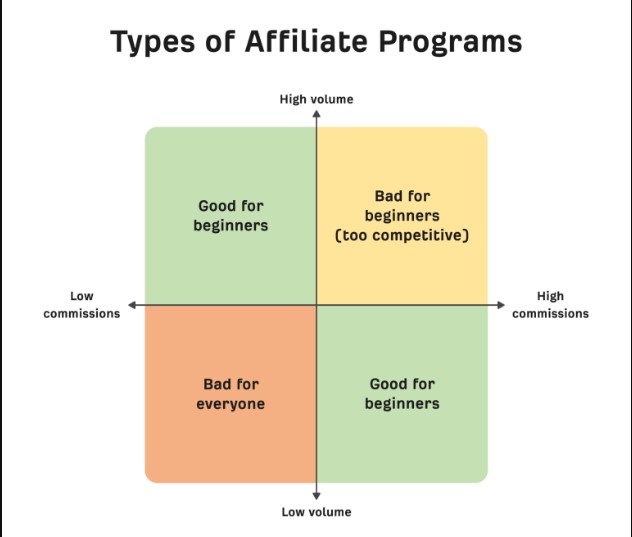 Now you might be wondering which affiliate program to join since there are three different programs. Well, the answer depends on your niche, and your level of expertise. If your focus is on reaching consumers, opt for the second approach: low-paying but high-volume. For businesses, prioritize the first approach: high-paying but low-volume. Affiliate programs that are popular in these categories often revolve around software and web hosting products.
Now you might be wondering which affiliate program to join since there are three different programs. Well, the answer depends on your niche, and your level of expertise. If your focus is on reaching consumers, opt for the second approach: low-paying but high-volume. For businesses, prioritize the first approach: high-paying but low-volume. Affiliate programs that are popular in these categories often revolve around software and web hosting products. 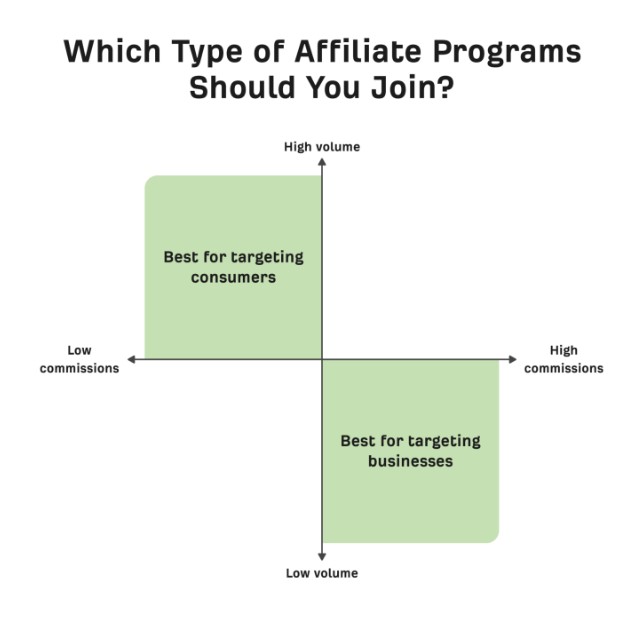 The best place to find good affiliate programs is through Google search. You can quickly search for “Best affiliate marketing programs” and Google will provide you with a list of options to select from.
The best place to find good affiliate programs is through Google search. You can quickly search for “Best affiliate marketing programs” and Google will provide you with a list of options to select from.
If there is a product you’d like to promote but they don’t have a public affiliate program, you can as well reach out to the company and ask if they would be willing to build an affiliate relationship with you.
Step 4: Create great content
 To ensure the success of your affiliate site, it is important to produce top-notch content that seamlessly incorporates your affiliate links. Avoid simply curating products solely based on Amazon’s best sellers. Instead, go the extra mile by crafting content that genuinely addresses your readers’ issues and concerns. For instance, if your focus is on writing reviews, consider actually purchasing and testing the products yourself. Dedicate time to using the products extensively and documenting your firsthand experiences and observations. By doing so, you provide valuable insights to your audience, enhancing the credibility and usefulness of your content. If you can also collaborate with other experts in your field to review the products you want to affiliate for, that is even a plus for you as it creates a sense of authenticity for your audience.
To ensure the success of your affiliate site, it is important to produce top-notch content that seamlessly incorporates your affiliate links. Avoid simply curating products solely based on Amazon’s best sellers. Instead, go the extra mile by crafting content that genuinely addresses your readers’ issues and concerns. For instance, if your focus is on writing reviews, consider actually purchasing and testing the products yourself. Dedicate time to using the products extensively and documenting your firsthand experiences and observations. By doing so, you provide valuable insights to your audience, enhancing the credibility and usefulness of your content. If you can also collaborate with other experts in your field to review the products you want to affiliate for, that is even a plus for you as it creates a sense of authenticity for your audience.
Step 5: Drive traffic to your affiliate Platform
 Now that you have created content, the next thing you want to do is drive traffic to your affiliate platform. Here are three traffic strategies to put into consideration;
Now that you have created content, the next thing you want to do is drive traffic to your affiliate platform. Here are three traffic strategies to put into consideration;
1. SEO
SEO involves the optimization of web pages with the goal of achieving high rankings in search engines like Google.
- Understanding what your target customers are searching for
- Creating content around those topics
- Making sure Google understands clearly what your page is about
- Acquiring links to push your pages higher in the search engines
- Ensuring Google can find, crawl, and index your content
2. Build an email list
An email list gives you access and allows you to communicate with your readers anytime. You can use their emails to tell them about new content and keep them coming back to your site for more. This leads to more affiliate clicks and sales. You can even add affiliate links in the emails to your audience like this:
To build an email list, you just need to persuade the readers on your site to sign up with their emails. That means offering them something of great value, like a free eBook, an email course, and more.
3. Paid traffic
Paid traffic involves you paying some money to get massive views on your site. You can do this using pay-per-click (PPC) ads. The advantage of paid traffic is, the moment you start paying, you get traffic. So if you want to take affiliate marketing in Canada really seriously, you might consider paying for traffic.
However, there are some downsides; Firstly, the moment you stop paying for the traffic, your traffic drops instantly. And secondly, running ads will dig into your profits. But generally speaking, if you’re part of a high-paying affiliate program, you can make the numbers work.
However, if you are a beginner in paid marketing and lack a marketing budget, or if you are working with affiliate programs that offer lower commissions like Amazon Associates, pursuing paid marketing may not be the most suitable approach.
Step 6: Get clicks on your affiliate links
Just because you’ve written a beautiful piece of content doesn’t mean people will click on your link. There are a few things to consider to increase the click-through rate;
Link placement
If you decide to place your affiliate links at the bottom of your page, don’t be surprised you’d have massive views and only a few clicks because viewers rarely scroll all the way to the bottom of the page. Also, if you place a link on every word in your introduction, your content will look spammy so you have to know the right place to place your links. I’d show you how in the next section.
Context
For instance, you’re writing content for the best gaming pads under $150. Your introduction shouldn’t look like this:
You will agree with me that the links look out of context and spammy. Instead, your content should look like this:
Today, I’d be reviewing five different gaming pads you can buy on Amazon for under $150. These are, product name 1, product name 2, product name 3, and so on.
Callouts
Incorporating attention-grabbing elements such as buttons, tables, and boxes can effectively capture your readers’ interest and enhance the scanability of your post. For example, the Wirecutter employs visually appealing boxes that include product links whenever they highlight a top pick. 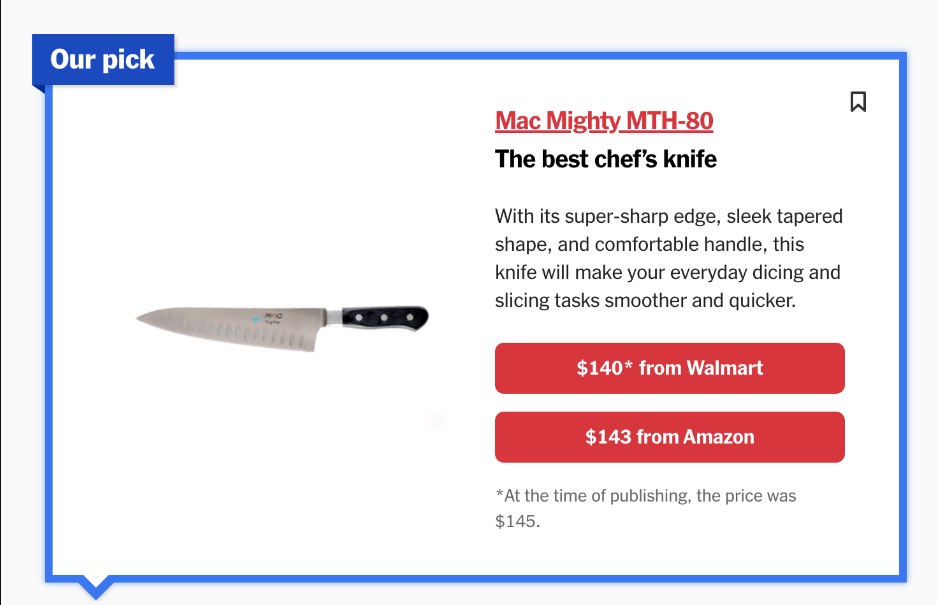 Good Housekeeping also takes on a different approach and creates a table with buttons:
Good Housekeeping also takes on a different approach and creates a table with buttons: 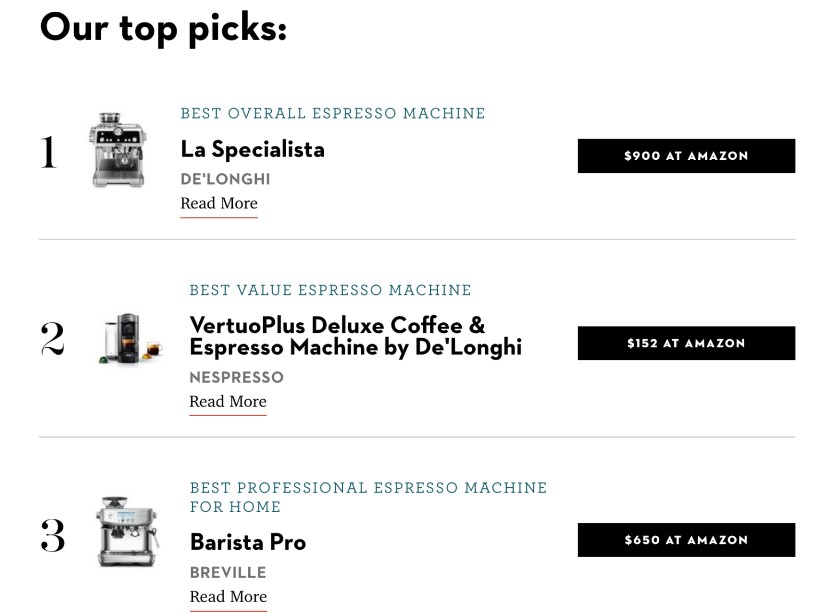
Step 7: Convert clicks to sales
 In affiliate marketing, there are two important conversions that must occur for you to make a profit; The first conversion is when a visitor clicks on the product page. You have full control over this action and can leverage the aforementioned tactics to increase the likelihood of obtaining that click. While the second conversion involves the visitor actually making a purchase. In affiliate marketing, the checkout process is controlled by the merchant, and their conversion rates are beyond your influence. However, the key is to optimize your approach and seek out merchants with high-converting programs, thereby maximizing your chances of success. Here are a few strategies to discover such merchants:
In affiliate marketing, there are two important conversions that must occur for you to make a profit; The first conversion is when a visitor clicks on the product page. You have full control over this action and can leverage the aforementioned tactics to increase the likelihood of obtaining that click. While the second conversion involves the visitor actually making a purchase. In affiliate marketing, the checkout process is controlled by the merchant, and their conversion rates are beyond your influence. However, the key is to optimize your approach and seek out merchants with high-converting programs, thereby maximizing your chances of success. Here are a few strategies to discover such merchants:
-
Public income reports
When individuals are earning a substantial income from an affiliate program, it generally indicates that the product has a high conversion rate. To know if people are making money, you can explore public income reports where bloggers openly disclose their earnings from affiliate partnerships. You can find several blog posts showcasing how bloggers have generated income through the Amazon Associates program on Google using the keywords “income report Amazon affiliate”. 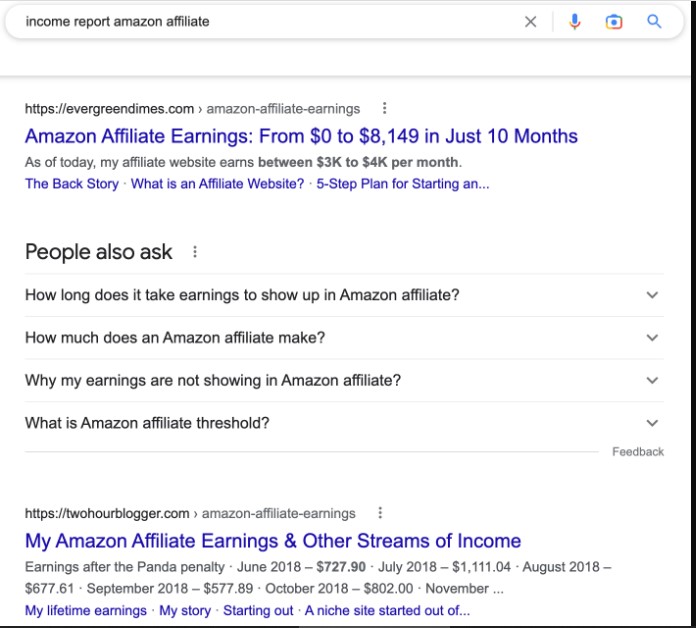 You can see from the image above that some people make up to 4k monthly and others make more. Reviewing these reports can provide valuable insights into the earning potential of specific affiliate programs.
You can see from the image above that some people make up to 4k monthly and others make more. Reviewing these reports can provide valuable insights into the earning potential of specific affiliate programs.
-
Ask questions
Another approach is to actively inquire and ask questions when there is limited information readily accessible about an affiliate program you intend to join. By signing up for the program, you gain the opportunity to engage directly with the program administrators and seek clarification. You can inquire about vital details such as average conversion rates or approximate monthly commissions earned by top performers. This valuable information can assist you in evaluating the viability of promoting the affiliate program and determining if it aligns with your goals and expectations.
-
Use your intuition
At times, trusting your intuition can be the wisest course of action. If, while evaluating a program or product, you have a sense that something doesn’t feel right or you personally wouldn’t endorse the product to a friend or family member, it’s best to refrain from promoting it. Maintaining integrity and ensuring that the products you promote align with your values and standards is crucial for building trust with your audience. By following your gut feeling and only endorsing products you genuinely believe in, you can establish authenticity and credibility in your affiliate marketing endeavours.
Best Drivers of Affiliate Marketing in 2023 Aside from the normal ways of promoting affiliate marketing links, there are other methods that can help you maximize the clicks on your affiliate links. In this section, we’ll be talking about the best drivers of traffic when it comes to affiliate marketing in Canada.
Blogging
As stated before, affiliate marketing is one of the big ways that bloggers make money in this game.
And how it works is pretty straightforward. All Bloggers generally specialize in a niche so they share products and services aligned with their niche to their audience. For example, it could be sport wears, sports shoes, and so on.
These types of affiliate program works well with sport-focused blogs and then you can niche down to Football, Basketball, and so on. To integrate affiliate marketing into your blog, you can incorporate links within your blog posts, insert banners, videos, and even pop-ups.
However, it’s crucial to ensure that you only include links when they’re natural and don’t oversell. Also, prioritize sharing links that offer genuine value and usefulness to your subscribers, rather than solely focusing on making sales, prioritize providing value first and foremost.
Social Media Sites
As mentioned above, social media sites too can be of good leverage when it comes to affiliate marketing in Canada however, before jumping on any social media site, it is important to check that your ads comply with their guidelines. Take Facebook for example. If you have a large following audience, sharing your affiliate links on Facebook could be very beneficial to you. Some ways you can share your links include the following;
- Groups
- Facebook Ads
- Personal Page
- Promotional Posts
Influencer Marketing
In today’s affiliate marketing landscape, influencers play a significant role, particularly due to the rise of social media platforms like YouTube and Instagram.
There are many famous influencers in the world today including the likes of Selena Gomez, Kim Kardashian, etc. And with the help of social media, a lot of ordinary people are rising to fame faster than it has ever been.
Microsites
Microsites, also known as mini-sites, serve as distinct entities separate from the main website, primarily intended to cater to particular target audiences. Companies frequently employ microsites in conjunction with other marketing strategies such as blogging or social media campaigns. The structure of a microsite can range from single-page setups designed to promote specific products or services to more extensive collections of pages. These microsites may have their own unique domain or exist as sub-domains within the main website. Typically, brands make use of microsites to highlight something specific. This could be:
- Products
- Campaigns
- Individual events
- Content/branded content
However, it’s not just brands using microsites. Regular affiliates create them, too. Here is an example: 
- Write detailed, media-rich content.
- Highlight features and benefits so visitors can read content at a glance.
- Include a mix of content to suit visitors’ preferences—for example, video content.
- Add reviews of products you’ve tried and tested—and be honest.
- Use a combination of products from different affiliate programs for a more comprehensive mix.
- Have a range of products at different price points.
- Include a “Check Price On Amazon” hyperlink, taking visitors directly to your affiliate products.
Videos/Webinars
Video content is one of the fastest ways to get your audience’s attention. People tend to enjoy video content more than written words so you can leverage that information and share video content with your audience. Video content has a lot of benefits; Firstly, you will agree with me that video content is easily consumable, and it does the “Showing” instead of the “Telling”. For example, you want to advertise a mud bike and how strong it can be. The best way to sell it to your audience is by making a short video of its performance, uploading it on your affiliate site, and including your link in the bio of the video. The webinar also shows marketers how to use influencers to leverage branded content ads. This allows brands on numerous social media platforms to collaborate with influencers and raise brand awareness through advertisements. That’s a win-win arrangement that turns content into commerce. Consider using these choices to build consumer trust and if video demonstrations help demonstrate the benefits of your product.
Coupons
Coupons are another way to drive sales as an affiliate marketer. You must have stumbled on a post that says “Use this coupon code to get a 50% discount”. Some product gives coupon codes instead of referral links and trust me, coupon codes always win. A recent vericast study shows that retailers can retain brand loyalty and win new customers with coupons. Putting coupons in your posts or giving an influencer a custom coupon code to interact with their audience can gain you massive sales. This is also a great way to get ahead of the competition within your niche.
Affiliate Marketing Tools
As I promised at the beginning of this post, I will be sharing some tools that can aid your journey in affiliate marketing in Canada. these tools can help you get the job faster, and easier;
- Ahrefs: All-in-one SEO tool that’ll help you research keywords to target, audit your website, research your competitors, find content ideas, and more.
- Rank Math: WordPress plugin that ensures your pages have optimal on-page SEO.
- Google Search Console: Find and fix technical errors on your website, submit sitemaps, see structured data issues, check your Core Web Vitals, and more.
- Google Analytics: Provides crucial data and analytics for your affiliate website.
- Thirsty Affiliates: Keep track of your affiliate links, see statistics to know which links are getting the most clicks, and prevent others from easily copying your website and swapping the links with their own affiliate IDs.
FAQs
Why should you do affiliate marketing?
There are several reasons why you can, and should do affiliate marketing in Canada. Here are a few reasons that stand out;
- Easy to scale: A typical salesperson only sells products from one company. As an affiliate marketer, you can promote products from many different companies and earn commissions from all of them.
- Low cost and risk: Starting a business can be risky and expensive because there are upfront costs for products, employees, equipment, rent, etc. With affiliate marketing, all you need is a website. If it doesn’t work out, you’ve only wasted time and a little bit of money.
How do I get started in affiliate marketing as a beginner?
To start affiliate marketing in Canada as a beginner, you need to find your niche, look for affiliate programs to join, create content around the product, and include your link.
Do I need a website to start affiliate marketing?
No. While starting a blog to drive traffic and make sales is a good approach to affiliate marketing in Canada, you don’t always need a blog/website to start affiliate marketing. There are several other platforms that you can leverage to reach your audience like Facebook, Instagram, YouTube, etc. As long as you have a way to drive people to your affiliate links, you can do affiliate marketing in Canada.
How do I choose the right affiliate program?
It all depends on your niche. Carefully examine the types of products you find interest in, list them out and pick the ones that you know you can seamlessly create content around.
What is EPC in affiliate marketing?
EPC stands for earnings per click. It refers to the average amount of money you earn each time someone clicks your affiliate links. Here’s how to calculate EPC: EPC = total amount of commissions you earn / number of clicks on your affiliate links
How much can a beginner make in affiliate marketing?
Conclusion on Affiliate Marketing Canada
Affiliate marketing is one of the fastest ways to earn money online. Simply by reviewing other people’s products, you can sit in the comfort of your home and earn money from commissions.
However, it is important to note that as with other ways of making money online, affiliate marketing takes time. You shouldn’t expect to get in today and make $10,000 in a month.
While that is possible, you must have put in the work, and have a standard audience. It is important to carefully examine your niche before diving into any affiliate program, and carefully select a platform that you can use to gather your audience.
Whether its a website you’re using, or a YouTube channel, or social media, make sure the products you share are relevant to your audience, and steer clear of any shady practices.
Goodluck!

